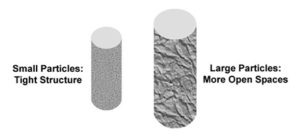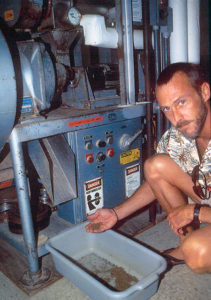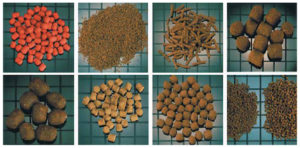
Grow-out test of freshwater prawns finds effects of feed protein levels limited
The development of technological innovations would improve the economic viability of freshwater prawn culture in the Mississippi Delta.
The effects of long steam preconditioning times of up to 30 minutes on the water stability of shrimp feeds were evaluated in early research studies.

The development of technological innovations would improve the economic viability of freshwater prawn culture in the Mississippi Delta.

The potential for NIR spectroscopy for rapid and accurate prediction of the chemical composition of fishmeal and soybean meal deserves investigation.

Several tools can help control the density of extruded marine fish feeds, including vented extruder barrels and separate cooking and forming extruders.

A study by the AKVAFORSK Institute of Aquaculture Research sought to determine if extrusion temperatures negatively affect digestibility of nutrients in aquafeed.

To obtain highly water stable pelleted feeds, the mash should be preconditioned for more than 90 seconds at temperatures higher than 90 degrees-C.

The mixing process is the heart of aquatic feed manufacturing. All the ingredients of a formula designed for the target animal are put together.

The first processing step in the production of shrimp feeds is the grinding of ingredients for a formula, either individually or as a group.

Aerated microbial reuse systems utilize intense aeration and mixing to produce yields of 10 to 30 metric tons per hectare per cycle with little or no water exchange.

An optimal maturation diet is a crucial factor in the successful sexual maturation and reproduction of shrimp in breeding operations.

Oceanic Institute documents a shrimp feed processing method involving large feed crumbled into smaller feed particles to produce various diet sizes.

Extrusion cookers and extruders have similarities and many not-so-subtle differences that have effects on end products' characteristics.

High-quality aquatic feed manufacturing depends on accurate definition of nutrition requirements, selection of quality ingredients and proper methods.

Phytase is a phosphatase enzyme with a specificity of action for the phosphate groups on the phytic acid structure, cleaving off those groups in a strict order.

The increasing production of tilapia is increasing the demand for fishmeal as a protein source for formulated aquafeeds.

The higher cost of feeds for RAS can be offset by better management, since it is easier to feed frequently and monitor uneaten or wasted feed.